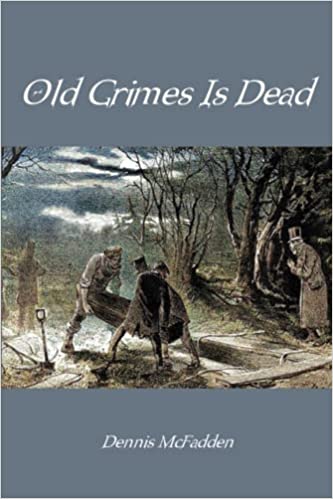Title Old Grimes is Dead – Author Dennis McFadden

Reviewer Carole A. Briggs
The title Old Grimes is Dead comes from an old Yorkshire folk song and lines from it are threaded throughout the narrative of Dennis McFadden’s latest book, a tale that gives voice to five of the seven ghouls, the group of seven men who exhumed the body of Henry Sutherland in 1857. In fiction form, he weaves a tale of deaths, exhumations, fugitives and more that occurred in fictitious Hartsgrove, aka Brookville, Pennsylvania.
McFadden grew up in Brookville, the site of the real exhumation, and like many natives, is familiar with the “Resurrection” story. During the time when anatomy could only be studied in Pittsburgh or Philadelphia, five doctors, a druggist, and a relative newcomer to town made plans and carried out the exhumation of a Black logger to establish an anatomy school. The plan went awry, and the youngest doctor was charged with grave-robbing and fined. In Old Grimes, four doctors and a school chum plan and carry out the exhumation of a Black shoemaker, and there begins the tale.
McFadden’s familiarity with Brookville is evident. Once exhumed, the ghouls transport Van Pelt’s (Sutherland’s) body “down Prospect Street (Pickering)…past Coal Alley, across Jefferson….” True to this point, but the actual “small bedroom off the kitchen” was not in a house south of Main Street, but rather a vacant house on Main Street rented or owned by the young doctor’s mentor. Does it make a difference? Probably not.
McFadden’s young Dr. Darling is accused of a second exhumation and imprisoned once again. Meanwhile, “cargoes” of fugitives are delivered to the nearby Black community, and readers are introduced to Brookville’s Black community including Black Hen, Yellow Charlie, Lucindy, and the subject of the exhumation, Fudgeon Van Pelt.
The author does a superior job of fleshing out his characters, both Black and White. A fugitive has “a balding head like Fudge’s, cheeks less bony, jaw only slightly fuller. His pants were torn at the knee and held up with twine, and his shirt was white and roomy, a cast-off from some charitable donor.” Darling’s mentor, Vasbinder, is “a balding man, stocky, with a bushy white mustache and eyes of cloudy gray. He possessed an odd, beseeching way of blinking both of his eyes simultaneously, a symptom of his sincerity….”
Writing dialogue for characters that lived nearly two centuries ago is as daunting as writing Black dialogue today, yet McFadden has done a credible job. Imprisoned alongside several Black men, Dr. Darling expresses his fondness for Fudge and why the resurrection was important. “No need to talk down to us, Doc. Not all us niggers are shuffling, fawning, wide-eyed simpletons….” McFadden’s Black characters are not stereotypes, rather they are portrayed as thoughtful and reflective.
His characters, both Black and White, dream, half-dream, daydream, and ponder much about the events they are experiencing, a technique that gets the reader inside their psyches and into the issues of that time. The young doctor dreams of Kathleen. Yellow Charlie invades Hen’s dreams again and again, and a feverish Fudge dreams of floating down Potters Creek, (North Fork).
Dreams and conversations touch on issues faced by this pre-Civil War rural population: eclectic and allopathic medicine, abolition and the Fugitive Slave Law, local politics, and unrest in Kansas. They touch on the feelings of doctors and patients, of former Black slaves and free Blacks.
McFadden knows his history and is familiar with McKnight’s writing, recalling events both serious and funny, like the egg-stealing episode recounted in McKnight’s 1917 history. He is also very good at turning the bodily functions of one old man into a hilarious predicament.
The book covers three months, ending in January 1858. Historically, the youngest doctor, William James McKnight, McFadden’s William Darling, moved on to serve in the Civil War, practice medicine in Jefferson County, become a state senator, and was the force behind Pennsylvania’s Anatomical Law of 1883 that legalized the use of unclaimed bodies for medical education, and wrote several volumes of history.
Readers will find this tale, as I did, to be a well-written one with descriptive paragraphs worth rereading and enough foreshadowing to make putting it aside a difficult decision.
Copyright © 2022 Carole A. Briggs




I have just finished reading this book and was particularly impressed by the development of the tender relationship between Black Hen and Lucindy.
Being the sleuth that I am, I had an inkling of the outcome early on, but will not reveal it here. Well done Dennis!